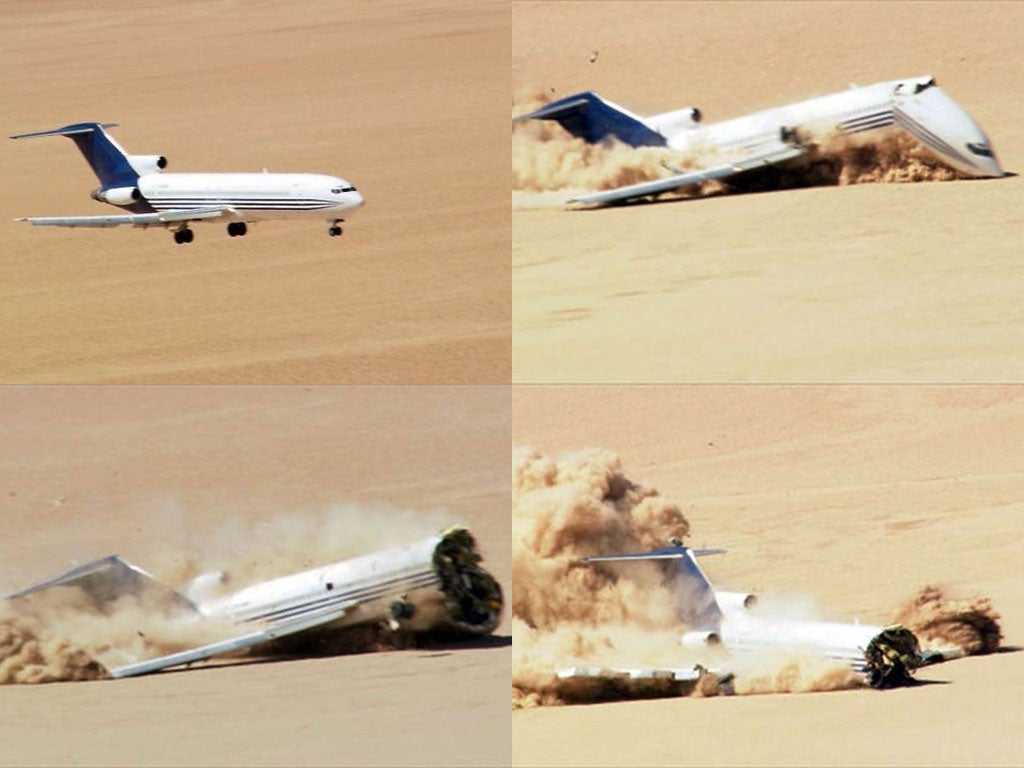Plane that landed with a bang
Adam Sherwin on the lengthy battle to bring an airliner plummeting down to earth

For a dedicated team of aeronautics experts and television producers, the moment when a Boeing 727 passenger jet crash-landed into the Mexican desert, ripping its fuselage in half, marked the fulfilment of a long-held dream.
The explosive sequence, screened last night in the Channel 4 documentary The Plane Crash, was first hatched four years ago as a seemingly insane and certainly highly dangerous proposal, which alarmed broadcasters and safety authorities.
The idea, to deliberately crash-land a 170-seat Boeing 727 passenger jet, was seized upon by an international team of scientists, experts and elite pilots as a unique opportunity to study the mechanics of a plane crash in real time.
Flight experts wanted to create a serious, but survivable, "forced landing" crash. The plane would not carry real passengers but crash test dummies, including three special models worth £100,000 each.
Accelerometers would measure the G forces withstood by the "passengers" and the 140 mph impact would be recorded by dozens of cameras inside the aircraft, on the runway, on a following "chase" plane and on the pilot's helmet.
The concept, first sent by producer Geoff Deehan as a one-line, wish-list proposal, "crash a passenger jet", to Channel 4 executive David Glover, had to offer more than simply dramatic footage for a ratings-hungry broadcaster.
The data collected would allow scientists to study the crashworth- iness of the aircraft's airframe and cabin, examine the impact of crashes on the human body and look at measures to increase passenger survivability.
Although car manufacturers regularly perform impact tests, no commercial airline company had dared conduct their own crash. "It was an insanely difficult escapade," said Glover, C4's science commissioning editor. "It has taken four years to make this happen. This was our Heart of Darkness. I thought we were jinxed at times."
The project was delayed as safety authorities refused to sanction the experiment. US aviation officials said the crash could not take place on its soil. Co-producer National Geographic pulled out.
"The great fear was we'd lose control of the plane and it would fly into a town," Glover admits. The jet they intended to use contained depleted uranium in its wings, threatening a minor environmental catastrophe.
Eventually Mexico's civil aviation authority granted permission for the British production company Dragonfly and the Discovery Channel to stage the crash in a remote and uninhabited corner of the Sonoran Desert.
The passenger jet was piloted by Fed Ex captain James "Jim Bob" Slocum, who has previously survived three plane crashes. The crew parachuted from the aircraft minutes before impact.
The aircraft was then flown remotely from a following aircraft descending, at a rate of 1,500 per minute. The impact of the nose-first crash destroyed the cockpit and the front row of seats, tearing away the aircraft's landing gear. Police, security and fire-safety officers formed an exclusion zone around the site and no damage to people or property was reported.
Scientists, including Anne Evans, a former senior air crash investigator at the Air Accidents Investigation Branch who examined the Lockerbie crash, pored over the crash site.
They concluded that passengers in the front few rows of the plane would almost certainly not have survived the crash – a warning to first-class ticketholders – and the crew would most likely have been killed too.
Passengers in the centre of the plane would have survived with minor injuries. Yet passengers at the rear would have been mostly unharmed.
When the aircraft came down, Mr Glover, observing from a desert viewing point, admitted that he was a nervous wreck. "The nightmare scenario was that the plane cartwheeled down the runway destroying all our scientific equipment, then we would have learnt nothing. But the scientists came away really pleased because this replicated the most common form of crash."
Aeronautics engineers will use the evidence collected by the programme to help strengthen the cockpit and front section of airliners. Channel 4 is keen to stress that the chances of being involved in a plane crash are actually statistically negligible. "I was offered an upgrade nearer the front on the flight back to Mexico and I didn't turn it down," Mr Glover said.
Mr Glover, who also brought Channel 4's Drugs Live ecstasy trial to screens, is now looking for the broadcaster's next "big bang" project. Recreating a train crash, or a nuclear reactor meltdown? "Whatever it is, it has to have a scientific purpose," he said. "But I wouldn't be able to do any of this without the backing of the team at Channel 4."
The Plane Crash is repeated at 9pm on Friday on 4Seven and is available on the 4oD catch-up service.
Subscribe to Independent Premium to bookmark this article
Want to bookmark your favourite articles and stories to read or reference later? Start your Independent Premium subscription today.

Join our commenting forum
Join thought-provoking conversations, follow other Independent readers and see their replies